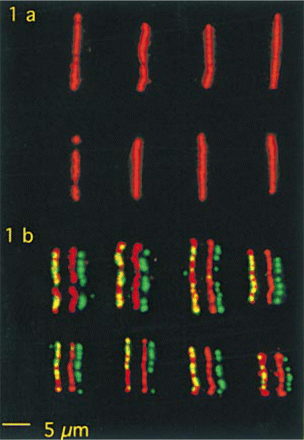
InSitupedia
ISH is a practical techniqueused in Cytogenetics and Molecular Genetics since 1980.
-
Fluorescent probes can be used for direct as well as indirect ISH experiments: probes are tagged with fluorophores or labeled with Biotin or Digoxigenin, followed by a second signal detection coupled with fluorochrome.
-
Is very sensitive and has high resolution.
-
Needs Fluorescence microscopes.
FISH is used for:
-
Chromosomal gene mapping.
-
Characterization of genetic aberrations.
-
Identification of genetic abnormalities (genetic disease or neoplasmic disorders).
-
Detection of viral genomes in interphase nuclei or metaphase chromosomes.
Fluorescence In Situ Hybridization (FISH)


Stellaris RNA FISH or Single Molecule RNA FISH is a mRNA detection method that allows simultaneous detection, localization and quantification of individual RNA molecules at a cellular level of a fixed sample.
It is:
-
Simpler- has an easy protocol with no exotic reagents.
-
Faster-can achieve same day results
-
More sensitive
-
Less expensive.
Allows visualization of the mRNA in cytoplasm as well as the active sites of transcription in the nucleus.
Does not really on artificial amplified signal, Stellaris probes directly quantify mRNA providing more confidence in the results.
Can be combined with immunohistochemistry, Western Bolt, PCR.
Can be used as a follow-up experiment to quantitative PCR, or imaged simultaneously with a fluorescent antibody assay.
The technology has potential applications in: drugs screaming; cancer diagnostic; Neuroscience; gene expression analysis, comparrison diagnostics.
Stellaris RNA FISH Probes (you tube)

FISH to DNA fibers (1996) is a high-resolution, wide-ranging physical DNA mapping method that finds increasing application in the study of pathological gene rearrangements.
Gained considerable interest in genomics as an adjunct physical mapping tool.
With its high and wide-ranging resolution (1 kb-1 Mbp) as well as its gene color bar-coding capacity. It is suited for molecular pathology research because it allows the investigation of DNA rearrangements in genetic diseases with much larger genomic scope than Southern Hybridization PCR.
DNA Fiber-FISH Staining Mechanism

Quantitative Fluorescent in situ hybridization is a cytogenetic technique based on the traditional FISH methodology. In Q-FISH, the technique uses labeled synthetic DNA mimics, called peptide nucleic acid (PNA) oligonucleotides, to quantify target sequences in chromosomal DNA using fluorescent microscopy and analysis software to quantify fluorescence intensity.
This technique is used routinely in telomere length research, which in vertebrates are repetitive hexameric sequences located at the distal end of chromosomes. Telomeres are necessary at chromosome ends to prevent DNA-damage responses as well as genome instability.
Determination of Telomere Length by the Quantitative FISH (Q-FISH) Method
Quantitative FISH Image Analysis for Telomere Length Measurements

Flow-FISH is a cytogenetic technique used to quantify the copy number of specific repetitive elements in genomic DNA of whole cell populations via the combination of flow cytometry with cytogenetic FSIH staining protocols.
Flow-FISH is most commonly used to quantify the length of telomeres, which are stretches of repetitious DNA (hexameric TTAGGG repeats) at the distal ends of chromosomes in human white blood cells. Telomere length in white blood cells has been a subject of interest because telomere length in these cell types declines gradually over the human lifespan, resulting in cell senescence, apoptosis or transformation.
Flow cytometry and FISH to measure the average length of telomeres (flow FISH)

Turbo FISH is a method for rapid single molecule RNA FISH that allows hybridization to be reduced from 2–16 hours to no more than 5 minutes.This method uses higher probes concentration, smaller hybridization buffers volumes and alcohol fixative. Turbo FISH allows the use all the potentials of this technique to rapid medical diagnostics and other medical applications.
Turbo FISH: a method for rapid single molecule RNA FISH
